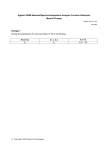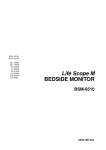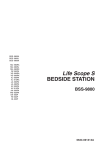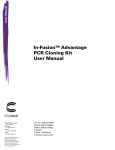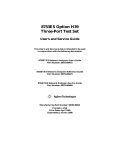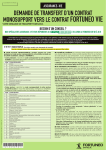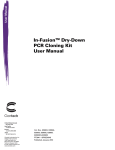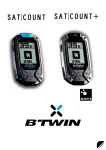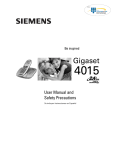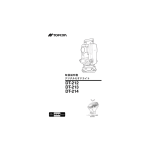Download Operation and Service Manual
Transcript
Operation and Service Manual Agilent 87511A/B S-PARAMETER TEST SET SERIAL NUMBERS This manual applies directly to instruments with serial number prex 3026J (87511A) and 3042J (87511B). For additional important information about serial numbers, read \INSTRUMENT COVERED BY MANUAL" in Chapter 1. Agilent Part No. 87511-90010 Printed in JAPAN July 2001 Third Edition Notice The information contained in this document is subject to change without notice. This document contains proprietary information which is protected by copyright. All rights are reserved. No part of this document may be photocopied, reproduced, or translated to another language without the prior written consent of the Agilent Technologies. Agilent Technologies Japan, Ltd. Component Test PGU-Kobe 1-3-2, Murotani, Nishi-ku, Kobe-shi, Hyogo, 651-2241 Japan c Copyright 1990, 2000, 2001 Agilent Technologies Japan, Ltd. Manual Printing History The manual printing date and part number indicate its current edition. The printing date changes when a new edition is printed. (Minor corrections and updates which are incorporated at reprint do not cause the date to change.) The manual part number changes when extensive technical changes are incorporated. October 1990 First Edition (part number: 87511-90000) February 2000 Second Edition (part number: 87511-90000) July 2001 Third Edition (part number: 87511-90010) :::::::::::::::::::::::::::::::::::: ::::::::::::::::::::::::::::::::: :::::::::::::::::::::::::::::::::::::: iii Safety Summary The following general safety precautions must be observed during all phases of operation, service, and repair of this instrument. Failure to comply with these precautions or with specic WARNINGS given elsewhere in this manual violates safety standards of design, manufacture, and intended use of the instrument. The Agilent Technologies assumes no liability for the customer's failure to comply with these requirements. DO NOT Operate In An Explosive Atmosphere Do not operate the instrument in the presence of ammable gasses or fumes. Operation of any electrical instrument in such an environment constitutes a safety hazard. Keep Away From Live Circuits Operating personnel must not remove the instrument covers. Component replacement and internal adjustments must be made by qualied maintenance personnel. Do not replace components with the power cable connected. Under certain conditions, dangerous voltages may exist even with the power cable removed. To avoid injuries, always disconnect power and discharge circuits before touching them. DO NOT Service Or Adjust Alone Do not attempt internal service or adjustment unless another person, capable of rendering rst aid and resuscitation, is present. DO NOT Substitute Parts Or Modify Instrument Because of the danger of introducing additional hazards, do not substitute parts or perform unauthorized modications to the instrument. Return the instrument to a Agilent Technologies Sales and Service Oce for service and repair to ensure the safety features are maintained. Dangerous Procedure Warnings Warnings, such as the example below, precede potentially dangerous procedures throughout this manual. Instructions contained in the warnings must be followed. Warning Dangerous voltages, capable of causing death, are present in this instrument. Use extreme caution when handling, testing, and adjusting this instrument. iv Typeface Conventions Bold Italics Computer 4HARDKEYS5 NNNNNNNNNNNNNNNNNNNNNNNNNN SOFTKEYS Boldface type is used when a term is dened. For example: icons are symbols. Italic type is used for emphasis and for titles of manuals and other publications. Italic type is also used for keyboard entries when a name or a variable must be typed in place of the words in italics. For example: copy lename means to type the word copy, to type a space, and then to type the name of a le such as file1. Computer font is used for on-screen prompts and messages. Labeled keys on the instrument front panel are enclosed in 4 5. Softkeys located to the right of the CRT are enclosed in . NNNNN Certification Agilent Technologies certies that this product met its published specications at the time of shipment from the factory. Agilent Technologies further certies that its calibration measurements are traceable to the United States National Institute for Standards and Technology, to the extent allowed by the Institution's calibration facility, or to the calibration facilities of other International Standards Organization members. Warranty This Agilent Technologies instrument product is warranted against defects in material and workmanship for a period of one year from the date of shipment, except that in the case of certain components listed in Chapter 1 of this manual, the warranty shall be for the specied period. During the warranty period, Agilent Technologies will, at its option, either repair or replace products which prove to be defective. For warranty service or repair, this product must be returned to a service facility designated by Agilent Technologies. Buyer shall prepay shipping charges to Agilent Technologies and Agilent Technologies shall pay shipping charges to return the product to Buyer. However, Buyer shall pay all shipping charges, duties, and taxes for products returned to Agilent Technologies from another country. Agilent Technologies warrants that its software and rmware designated by Agilent Technologies for use with an instrument will execute its programming instruction when property installed on that instrument. Agilent Technologies does not warrant that the operation of the instrument, or software, or rmware will be uninterrupted or error free. v Limitation Of Warranty The foregoing warranty shall not apply to defects resulting from improper or adequate maintenance by Buyer, Buyer-supplied software or interfacing, unauthorized modication or misuse, operation outside of the environment specications for the product, or improper site preparation or maintenance. No other warranty is expressed or implied. Agilent Technologies specically disclaims the implied warranties of merchantability and tness for a particular purpose. Exclusive Remedies The remedies provided herein are buyer's sole and exclusive remedies. Agilent Technologies shall not be liable for any direct, indirect, special, incidental, or consequential damages, whether based on contract, tort, or any other legal theory. Assistance Product maintenance agreements and other customer assistance agreements are available for Agilent Technologies products. For any assistance, contact your nearest Agilent Technologies Sales and Service Oce. Address are provided at the back of this manual. vi Safety Symbols General denitions of safety symbols used on equipment or in manuals. Instruction manual symbol: the product will be marked with this symbol when it is necessary for the user to refer to the instruction manual in order to protect against damage to the instrument. Indicates dangerous voltage (terminals fed from the interior by voltage exceeding 1000 volts must be so marked). Protective conductor terminal. For protection against electrical shock in case of a fault. Used with wiring terminals to indicate the terminal which must be connected to ground before operating equipment. Low-noise or noiseless, clean ground (earth) terminal. Used for a signal common, as well as providing protection against electrical shock in case of fault. A terminal marked with this symbol must be connected to ground in the manner described in the installation (Operation) manual, and before operating the equipment. Frame or chassis terminal. A connection to the frame (chassis) of the equipment which normally includes all exposed metal structures. Alternating current (power line). Direct current (power line). Alternating or direct current (power line). Warning denotes a hazard. It calls attention to a procedure, practice, condition or the like, which, if not correctly performed or adhered to, could result in injury or death to personnel. Caution sign denotes a hazard. It calls attention to a procedure, practice, condition or the like, which, if not correctly performed or adhered to, could result in damage to or destruction of part or all of the product. Note denotes important information. It calls attention to a procedure, practice, condition or the like, which is essential to highlight. vii 1 General Information INTRODUCTION The purpose of this manual is to enable you to use your 87511A (including Option 001) or 87511B S-parameter test set eciently and condently. This manual contains both general and specic information. When information applies to both the 87511A (the 50 test set, including Option 001) and the 87511B (the 75 test set) the name 87511A/B is used. To use the 87511A/B to perform a specic function (without reading the entire manual), follow the directions in \USING THE 87511A/B". This chapter (1) outlines how to begin using the 87511A/B as quickly as possible, (2) describes what instrument are covered by this manual, (3) describes the test set itself, (4) mentions operating precautions, safety considerations and warranty restrictions, (5) lists the additional equipment required, and (6) denes and lists the required instrument specications. USING THE 87511A/B The 87511A/B has been designed to operate specically with the 8751A network analyzer. To install the instrument, turn to Chapter 2. To oprate the 87511A/B, see the Chapter 3. To verify that the instrument meets its published specications, turn to Chapter 4. to order replaceable parts of the 87511A/B, to turn to Chapter 6. To troubleshoot the 87511A/B, turn to Chapter 7. General Information 1-1 INSTRUMENTS COVERED BY MANUAL You will nd a two-part serial number on the rear panel of the test set. The rst four digits and the letter are the serial number prex. The last ve digits are the sequential sux which is unique to each test set. The contents of this manual apply directly to test sets with the same serial number prex as the one(s) on the title page under the heading SERIAL NUMBERS. If the serial prex of your test set is not listed on the title page, your instrument diers from those documented in this manual. The dierences are documented in the yellow manual changes supplement supplied with the manual. To keep this manual as current and accurate as possible, Agilent Technologies recommends that you periodically request the latest manual changes supplement, as it may contain replacement information as well as change information. The supplement for this manual is keyed to the manual's print date and part number (on the title page) and is available on request from Agilent Technologies. This manual is also available on microche form (the part number appears on the title page). With the manual (in 4 2 6 inch microlm transparency format) you will also receive the latest manual changes supplement. DESCRIPTION AND OPERATING CHARACTERISTICS OF THE INSTRUMENT The 87511A/B S-parameter test set has been designed to operate with the 8751A network analyzer. The 87511A/B provides a convenient means of measuring the reection and transmission coecients (scattering parameters) of one-port or two-port devices operating within the frequency range of 100 kHz to 500 MHz. Table 1-2 lists the operating specications and characteristics of the 87511A/B. The test set is shown on the cover of this manual and shown in Figure 3-1. 1-2 General Information OPTIONS Option 001, 50 Type-N Test Port (87511A only) Option 907, Front Handle Kit (Agilent Part Number 5062-3988) Option 908, Rack Mount Kit (Agilent Part Number 5062-3974) This option is a rack mount kit containing a pair of anges and the necessary hardware to mount the instrument, with handles detached, in an equipment rack with 482.6 mm (19 inches) horizontal spacing. Option 909, Rack Mount Flange and Handle Kit (Agilent Part Number 5062-3975) This option is a rack mount kit containing a pair of anges and the necessary hardware to mount the instrument with handles attached in an equipment rack with 482.6 mm (19 inches) horizontal spacing.) Option 910, Extra Operation Manual This option is an extra OPERATION AND SERVICE MANUAL. (Agilent Part Number 87511-90000) General Information 1-3 Figure 1-1. 87511A/B S-Parameter Test Set with Accessories Supplied ACCESSORIES Accessories Supplied Figure 1-1 shows the 87511A/B with the accessories supplied: Interconnect Cable RF Connecting Cables Accessories Available Calibration and Accessory Kits The calibration kits listed in Table 1-1 contain the components required to characterize the systematic errors of various measurement systems. The calibration kits also contain precision adapters. The accessory kits listed contain the components generally required to measure devices with the types of connectors indicated. Additional information is included in the 8751A manual. 1-4 General Information Table 1-1. Accessories Available Connector Type Calibration Kit Accessory Kit 7 mm Type-N 50 Type-N 75 BNC 50 1 85031B 85032B 85036B 11853A 1 11854A 1 use with 85032B type-N 50 calibration kit Cable Sets Use the 11857D 7 mm test port return cable set to extend the test ports of the 87511A. Use the 11851B 50 type-N cable to extend the test port of the 87511A with Option 001. Use the 11857B 75 type-N test port return cable set to extend the test port of the 87511B. OPERATING AND SAFETY PRECAUTIONS Operating You need observe only normal precautions in handling and operating the 87511A/B. Do not exceed its operating level input of +23 dBm or any DC voltage. Caution Electrostatic discharge (ESD) can damage the highly sensitive microcircuits in the 87511A/B test sets. ESD damage is most likely to occur as the test sets are connected or disconnected. Protect them by wearing a grounding strap that provides a path to ground of high resistance. Alternatively, ground yourself by touching the outer shell of any grounded instrument chassis before touching the test port connectors. Never touch the center contacts of the connectors. Use a work station equipped with an anti-static surface. Service The voltages in this test set do not warrant more than normal caution for operator safety. Nevertheless, service should be performed by qualied personnel. General Information 1-5 RECOMMENDED TEST EQUIPMENT Table 4-1 lists equipment and accessories required for testing, and repairing the 87511A/B. The table notes which items are required to verify the performance of the test set and which are required to troubleshoot it. Other equipment may be substituted if its specications meet or exceed the specications listed in the critical specications column. SPECIFICATIONS Definitions The specications listed in Table 1-2 range from those guaranteed by Agilent Technologies to those typical of most 87511A/B instruments but are not guaranteed. Codes in the far right column of Table 1-2 reference a specication denition listed below. These denitions are intended to clarify the extent to which Agilent Technologies supports the specied performance of the 87511A/B. S This performance parameter is eld veriable using performance tests documented in the Chapter 4. T Typical but non-warranted performance characteristics intended to provide information useful in applying the instrument. Typical characteristics are representative of most instruments, though not necessarily tested in each unit and not eld tested. 1-6 General Information These specications describe the analyzer's performance over the temperature range of 2365 C. Table 1-2. Specifications Parameter Frequency Range Directivity : Port 1,2 1 87511A 87511B 100 kHz to 500 MHz 100 kHz to 500 MHz 30 dB, 100 kHz to 300 kHz 40 dB, 300 kHz to 200 MHz 35 dB, 200 MHz to 500 MHz (37 dB, 300 kHz to 200 MHz) 30 dB, 100 kHz to 300 kHz 33 dB, 300 kHz to 500 MHz Code S 2 Port Match : R, A, B RF IN Switch Repeatability Source Match T 1 1 Frequency Response : Transmission Tracking Magnitude Phase 20 dB 20 dB 60.03 dB 20 dB 20 dB 60.03 dB 15 dB, 100 kHz to 300 kHz 20 dB, 300 kHz to 500 MHz 15 dB, 100 kHz to 300 kHz 20 dB, 300 kHz to 500 MHz S T 1 3 4 Reection Tracking Magnitude Phase 4 3 61 dB 610, 100 kHz to 300 kHz 65 , 300 kHz to 500 MHz 61 dB 615 , 100 kHz to 300 kHz 65 , 300 kHz to 500 MHz 61 dB 615, 100 kHz to 300 kHz 65 , 300 kHz to 1 MHz 65 , 1 MHz to 500 MHz 61 dB 620 , 100 kHz to 300 kHz 610 , 300 kHz to 1 MHz 65 , 1 MHz to 500 MHz Insertion Loss: RF IN to Port 1,2 13 dB RF IN to R, A, B 19 dB Isolation between 110 dB Port 1 and 2 1 2 3 4 Nominal 19 dB 31 dB 100 dB T can be greatly improved with 8751A accuracy enhancement techniques Option 001 only Deviation from mean value Deviation from linear phase General Information 1-7 Table 1-3. Specifications (continued) Parameter Impedance: Port 1, 2 RF IN, R, A, B Connectors: Port 1, 2 RF IN R, A, B Maximum Input Level Damage Level Operating Conditions: Temperature Relative Humidity Dimensions Weight Power 1 87511A Code Nominal 50 50 75 50 7 mm (50 ) 50 type-N(f) 50 type-N(f) +20 dBm 75 Type-N(f) +23 dBm +23 dBm 0 C to 55 C 95% at 40 C 432 mm 2 90 mm 2 495 mm (17 2 3.5 2 19.5 inches) 5.7 kg +22 Vdc from 8751A via interface cable (22 V, 20 mA typ.) 0 C to 55 C 95% at 40C 432 mm 2 90 mm 2 495 mm (17 2 3.5 2 19.5 inches) 5.7 kg +22 Vdc from 8751A via interface cable (22 V, 20 mA typ.) 1 Option 001 only 1-8 87511B General Information 50 type-N(f) +20 dBm 2 Installation INTRODUCTION This chapter explains how to install the 87511A/B test set. The topics covered include initial inspection, environment considerations, positioning and connecting the test set for use, and packaging the instrument. INITIAL INSPECTION Inspect the shipping container (including cushioning material) for damage. If it is damaged, keep it until you have checked the contents for completeness. The contents are listed in Table 2-1. In addition, check the test set mechanically and electrically. If the test set and shipping container are undamaged, performing the Directivity performance test in Chapter 4 should suce for incoming inspection. If the test set does not pass the performance test, refer to the troubleshooting procedures in Chapter 7. If the shipping container is damaged, perform all electrical performance tests in Chapter 4. If the test set fails the electrical tests, or is damaged, defective, or incomplete, keep the shipping materials and notify both the carrier and the nearest Agilent Technologies oce. The Agilent Technologies oce will arrange for repair or replacement of the test set without waiting for settlement of the claim. Table 2-1. Contents of the 87511A/B Component Interconnect Cable RF Connecting Cables Operation and Service Manual 1 1 Agilent Part Number 87511A 08503-60051 8120-4782 87511-90000 87511B 08503-60051 8120-4782 87511-90000 Consists of four cables Installation 2-1 ENVIRONMENTAL CONSIDERATIONS Operating and Storage The 87511A/B should be operated in temperatures between 0 C and +55 C with relative humidity between 5% and 95% at 40C (non-condensing). It may be operated at altitudes up to 4,500 meters (15,000) feet. The 87511A/B may be stored in temperatures from 040 C to +70 C, with relative humidity up to 90% at +65 C (non-condensing) and at altitudes up to 15,240 meters (50,000 feet). PREPARATION FOR USE Positioning the Test Set Typically the 87511A/B is placed under the 8751A network analyzer whether it is rack-mounted or used on a bench. To install the 87511A/B for use on a bench, place it under or next to the 8751A. Use an anti-static work surface to lessen the chance of ESD damage. Connecting the Test Set Mating Connectors Ports 1 and 2 of the 87511A are precision 7 mm connectors and mate with precision 7 mm connectors. Ports 1 and 2 of the 87511A Option 001 are precision 50 type-N female connector and mate with precision 50 male connectors. Ports 1 and 2 of the 87511B are precision 75 type-N female connector and mate with precision 75 male connectors. Caution Do not mate type-N 50 connectors to type-N 75 connectors or damage may result. The RF IN, R, A and B ports of the 87511A/B are precision 50 type-N female connectors which mate with the corresponding precision type-N male connectors whose dimensions conform to US specication MIL-C-39012. The NETWORK ANALYZER INTERCONNECT connector is a series D 25-contact female connector and mates with the corresponding male connector. Power and Control Connections Power for the 87511A/B is supplied by the 8751A network analyzer through the interconnect cable. The interconnect cable also transmits control signals between the test set and the network analyzer. Connect the interconnect cable from the NETWORK ANALYZER INTERCONNECT connector on the rear panel of the 87511A/B to the TEST SET INTERCONNECT connector on the rear panel of the 8751A. 2-2 Installation Signal Path Connections Place the test set under the network analyzer and connect its RF IN port to the network analyzer's RF OUT port, R to R, A to A, B to B. Use the four cables supplied with the test set. To connect the signal path ports with the test set not positioned under the network analyzer, use the longer cables of the 11851B RF cable set. Connect the RF IN port to the RF OUT port with the longer cable. Connect port R to R, A to A, B to B with the three phase matched cables. PACKAGING If shipping to a Hewlett Packard service center is required, each test set should be repackaged using the original factory packaging materials. Alteratively, comparable packaging materials may be used. Wrap the test set in heavy paper or anti-static plastic. Use sucient shock absorbing material on all sides of the 87511A/B to provide a thick, rm cushion and prevent movement. Seal the shipping container securely and mark it FRAGILE . In any correspondence with Agilent Technologies, refer to the 87511A/B by its full model and serial number. Installation 2-3 3 Operation INTRODUCTION This chapter illustrates the features of the front and rear panels of the 87511A/B (Figure 3-1 and Figure 3-2). Figure 3-3 shows a typical test set measurement setup. Figure 3-4 depicts the RF signal path through the test set for each of the four S-parameter measurements. Figure 3-1. Front Panel Features 1. This terminal is tied to the instrument's chassis and can be used for measurements that require guarding. 2. PORT 1. The device under test is connected here or to port 2 or to both Guard Terminal. Caution Do not input more than +23 dBm or any DC Voltage to PORT 1 and PORT 2. Note The connector for the PORT 1 terminal is designed with a MOVABLE TEST PORT; and this is not a defect. 3. This indicator lights when the test set is in the S11 or S21 measurement mode and power is incident from port 1. S11 S21 Indicator LED. Operation 3-1 4. 5. 6. 7. 8. 9. This indicator lights when the test set is in the S22 or S12 measurements mode and power is incident from port 2. PORT 2. The device under test is connected here or to port 1 or to both RF IN. This RF input connector receives the RF signal from the 8751A RF OUT connector. R. This RF connector provides the reference signal to port R of the 8751A. A. This RF connector provides an RF input signal to port A of the 8751A from the device under test. B. This RF connector provides an RF input signal to port B of the 8751A from the device under test. S22 S12 Indicator LED. Figure 3-2. Rear Panel Features 10. 3-2 NETWORK ANALYZER INTERCONNECT This connector supplies the test set with power from the network analyzer and also serves as a bidirectional control path. Operation Figure 3-3. Typical Measurement Setup Operation 3-3 Figure 3-4. RF Signal Path 3-4 Operation 4 Performance Tests INTRODUCTION This chapter provides the test procedures used to verify that the 87511A/B's specications listed in this manual are met. All tests can be performed without access to the interior of the instrument. The performance tests can also be used to perform incoming inspection, and to verify that the 87511A/B meets performance specications after troubleshooting or adjustment. If the performance tests indicate that the 87511A/B is NOT operating within the specied limits, check your test setup, and then proceed to Adjustments or Troubleshooting in the 87511A/B service manual, if necessary. Note Perform all performance tests in an ambient temperature of 23 C 6 5 C. PERFORMANCE TEST RECORD Record the performance test results in the Test Record at the end of this chapter (Photocopy the Test Record and use the photocopy). The Test Record lists all test specications and their acceptable limits. Test results recorded during incoming inspection can be used for comparison purposes during periodic maintenance, troubleshooting, and after repair or adjustment. Note The test limits indicated for each test do not take into account the measurement error of the test equipment used. Be sure to take the test equipment's measurement error into account when determining whether or not the 87511A/B meets specications. CALIBRATION CYCLE The 87511A/B requires periodic performance verication. The frequency of performance verication depends on the operating and environmental conditions under which the 87511A/B is used. Verify the 87511A/B's performance at least once a year, using the performance tests described in this chapter. Performance Tests 4-1 EQUIPMENT REQUIRED The equipment required for performance testing is listed in Table 4-1. Substitutions can be made for the equipment in this list if the specications meet or exceed the specications listed in the requirement column. Table 4-1. Recommended Test Equipment Instrument Network Analyzer Cable Calibration Kit Adapter Load Controller Disk Drive DVM 1 Critical Specications no substitute RF Cable Set ( 50 type-N, three 24 inch phase-matched, one 35 inch) Interconnect Cable RF connecting Cable, 4 ea. GPIB Cable no substitute 7 mm-N(f), 50 , 2 ea. Minimum Loss Pad type-N, 50 (return loss 49) HP Technical Computer with BASIC rev 5.0 or above CS80 DC: up to 22 V Only Used For Troubleshooting 4-2 Performance Tests 1 Recommended Model 8751A 11851B PN 87511-61609 PN 8120-4387 10833A 85031B 85032B 85036B PN 85054-60001 11852B 909F Opt.012 HP 9000 Model 310 9122A 3458A DIRECTIVITY TEST Directivity is a measure of the ability of a directive device (in this case the 87511A/B) to discriminate between incident and reected signals. In this procedure directivity is tested by using the internal bridge to measure the reection coecient of a standard termination. Since the return loss of the termination is much greater than the directivity of the test set, the measurement made in this procedure is essentially the directivity of the 87511A/B test set. Use the highest quality termination available as that factor determines the accuracy of the procedure. Specification Directivity Frequency Range 87511A 87511A 87511B Opt. 001 100 kHz Freq. 300 kHz 30 dB 30 dB 30 dB 300 kHz < Freq. 200 MHz 40 dB 37 dB 33 dB 200 MHz < Freq. 500 MHz 35 dB 35 dB 33 dB Test Equipment Test Equipment 87511A Network Analyzer Interconnect cable RF Cable Calibration Kit 50 Termination 8751A PN 87511-61609 PN 8120-4387 , 4 ea. 85031B 1 2 1 2 87511A Opt.001 87511B 8751A PN 87511-61609 PN 8120-4387 , 4 ea. 85032B 909F Opt.012 1 2 8751A PN 87511-61609 PN 8120-4387 , 4 ea. 85036B 1 2 This cable is supplied with test set. This cable is supplied with test set. Procedure Note By convention, when the connector sex is indicated in parentheses for a calibration standard, it refers to the sex of the test port connector (not the actual standard). For example, short (f) indicates that the test port connector, note the short circuit connector, is female. 1. Connect the equipment as shown in Figure 4-1. Performance Tests 4-3 Figure 4-1. Directivity Test Setup 2. Set the 8751A as follows: Control Settings Key Strokes PRESET Source Power = 0 dBm (87511A) Source Power = 10 dBm (87511B) Sweep Type: LOG FREQ IF BW = 200 Hz 4PRESET5 4MENU5 405 4x15 4MENU5 415 405 4x15 , , , , , 5, SWEEP TYPE MENU , LOG 5, IF BW , 4 5, 4 5, 4 5, 4 5 NNNNNNNNNNNNNNNNNNNNNNNNNNNNNNNNNNNNNNNNNNNNNNN 4MENU NNNNNNNNNNNNNNNNNNNNNNNNNN FREQ NNNNNNNNNNNNNNNNN 4AVG 2 0 0 x1 3. To set the system impedance, 87511A: Press 4 8751A Opt.001: Press 4 87511B: Press 4 , 5, 5, 5 CAL CAL CAL CAL KIT , 7 mm . NNNNNNNNNNNNNNNNNNNNN NNNNNNNNNNNNN CAL KIT , N 50 . NNNNNNNNNNNNNNNNNNNNN NNNNNNNNNNNNNNNNNN CAL KIT , N 75 . NNNNNNNNNNNNNNNNNNNNN NNNNNNNNNNNNNNNNNN 4. Press 4 5, CALIBRATE MENU , RESPONSE to enter the response calibration menu. 5. When prompted, connect the SHORT supplied with the calibration kit to the test set's TEST PORT 1. 6. Press SHORT ( SHORT[F] for 87511A opt. 001 and 87511B) to measure the calibration standard on the 8751A. 7. Press DONE: RESPONSE after the short has been measured. The status indicator \Cor" should appear at the left side of the display. 8. Remove the SHORT, and connect the following Termination to 87511A/B TEST PORT 1. NNNNNNNNNNNNNNNNNNNNNNNNNNNNNNNNNNNNNNNNNNNN CAL NNNNNNNNNNNNNNNNN NNNNNNNNNNNNNNNNNNNNNNNNNN NNNNNNNNNNNNNNNNNNNNNNNNNNNNNNNNNNNNNNNNNNNN 4-4 Performance Tests NNNNNNNNNNNNNNNNNNNNNNNNNN 87511A: 7 mm 50 Termination supplied with the 85031B 87511A Opt.001: Type-N 50 Termination (909F opt.012) 87511B: Type-N 75 Termination supplied with the 85036B 9. Perform the following key strokes to generate a single sweep. 4 5, TRIGGER MENU , SINGLE 10. Perform the following key strokes to set the marker search range from 100 kHz to 300 kHz. 5, 4 MODE MENU , 5, 4 4 5, ACTIVE MARKER , MARKER 2 , 4 5, 4 5, 4 5, 4 5, SEARCH RANGE , SEARCH RNG STORE , 4 REF MARKER , 4REF-1 , 4 NNNNNNNNNNNNNNNNNNNNNNNNNNNNNNNNNNNNNN NNNNNNNNNNNNNNNNNNNN MENU NNNNNNNNNNNNNNNNNNNNNNNNNNNNNNNNNNNNNNNNN NNNNNNNNNNNNNNNNNNNNNNNNNNNNNNNNNNNNN NNNNNNNNNNNNNNNNNNNNNNNNNN 0 3 MKR MKR k/m NNNNNNNNNNNNNNNNNNNNNNNNNNNNNNNNNNNNNN NNNNNNNNNNNNNNNNNNNNNN NNNNNNNNNNNNNNNNNNNNNNNNNNNNNNNNNNNNNNNN 0 NNNNNNNNNNNNNNNNNNNNNNNNNNNNNNNNNNNNNNNNNNNNNNNNNN MKR FCTN NNNNNNNNNNNNNNNNNNNNNNNNNNNNNNNNNNNNNNNNNNNNNNNNNNNNNNNN PART SEARCH on OFF 11. Perform the following key strokes to move the marker to the maximum point. Record the maximum reading value on the Performance Test Record. 5, 4 MODE MENU , 4 MODE OFF 5, MKR SEARCH , MAX , 4 4 12. Press 4 REF MARKER , 4REF-1 . 13. Perform the following key strokes to set the marker search range from 300 kHz to 200 MHz. 5, 4 5, ACTIVE MARKER , MARKER 2 , 4 5, ACTIVE MARKER , MARKER 1 , 4 5, 4 5, 4 5, 4 5, SEARCH RANGE , SEARCH RNG STORE 5, 4 4 5, 4 5, 4 5, 4 5, 4 5, 4 14. Perform the following key strokes to move the marker to the maximum point. Record the maximum reading value on the Performance Test Record. 5, 4 MODE MENU , 4 MODE OFF 4 5, MKR SEARCH , MAX , 4 15. Press 4 REF MARKER , 4REF-1 . 16. Perform the following key strokes to set the marker search range from 200 MHz to 500 MHz. 4 5, ACTIVE MARKER , MARKER 1 , 4 5, 4 5, 4 5, 4 5, 4 5, 4 5, 4 5, ACTIVE MARKER , MARKER 2 , 4 5, 4 5, 4 5, 4 5, 4 5, SEARCH RANGE , SEARCH RNG STORE 17. Perform the following key strokes to move the marker to the maximum point. Record the maximum reading value on the Performance Test Record. 5, 4 MODE MENU , 4 MODE OFF 5, MKR SEARCH , MAX , 4 4 18. Press 4 5, REFL:REV S22(B/R) . NNNNNNNNNNNNNNNNNNNNNNNNNNNNNNNN NNNNNNNNNNNNNNNNNNNNNNNNNNNNNNNNNNNNN NNNNNNNNNNN NNNNNNNNNNNNNNNNNNNNNNNNNNNNNNNNNNNNNNNN NNNNNNNNNNNNNNNNNNNNNNNNNNNNNNNNNNNNNNNNN NNNNNNNNNNNNNNNNNNNNNN NNNNNNNNNNNNNNNNNNNNNNNNNNNNNNNNNNNNNNNNN NNNNNNNNNNNNNNNNNNNNNNNNNN 2 MKR 0 0 k/m 9 9 . 7 NNNNNNNNNNNNNNNNNNNNNNNNNN MKR NNNNNNNNNNNNNNNNNNNNNNNNNNNNNNNNNNNNNN 1 NNNNNNNNNNNNNNNNNNNNNNNNNNNNNNNNNN MKR MKR FCTN NNNNNNNNNNNNNNNNNNNNNNNNNNNNNNNNNNNNNNNNNNNNNNNNNN MKR FCTN M/u NNNNNNNNNNNNNNNNNNNNNNNNNNNNNNNN NNNNNNNNNNNNNNNNNNNNNNNNNNNNNNNNNNNNN NNNNNNNNNNN NNNNNNNNNNNNNNNNNNNNNNNNNNNNNNNNNN MKR MKR FCTN NNNNNNNNNNNNNNNNNNNNNNNNNNNNNNNNNNNNNNNN NNNNNNNNNNNNNNNNNNNNNNNNNNNNNNNNNNNNNNNNN NNNNNNNNNNNNNNNNNNNNNN NNNNNNNNNNNNNNNNNNNNNNNNNN NNNNNNNNNNNNNNNNNNNNNNNNNNNNNNNNNNNNNNNNN 1 MKR 9 9 . 7 M/u NNNNNNNNNNNNNNNNNNNNNNNNNNNNNNNNNNNNNN NNNNNNNNNNNNNNNNNNNNNNNNNN 3 0 0 M/u NNNNNNNNNNNNNNNNNNNNNNNNNNNNNNNN MKR NNNNNNNNNNNNNNNNNNNNNNNNNNNNNNNNNNNNNNNNNNNNNNNNNN MKR FCTN NNNNNNNNNNNNNNNNNNNNNNNNNNNNNNNNNNNNN NNNNNNNNNNN NNNNNNNNNNNNNNNNNNNNNNNNNNNNNNNNNN MKR MKR FCTN NNNNNNNNNNNNNNNNNNNNNNNNNNNNNNNNNNNNNNNNNNNNNNNNNNNNN MEAS 19. Press 4 5, CALIBRATE MENU , RESPONSE , to enter the calibration menu. 20. WHen prompted, connect the SHORT supplied with the calibration kit to 87511A/B TEST PORT 2. 21. Press SHORT ( SHORT[F] for 87511A Opt. 001 and 87511B) to measure the calibration standard on the 8751A. NNNNNNNNNNNNNNNNNNNNNNNNNNNNNNNNNNNNNNNNNNNN NNNNNNNNNNNNNNNNNNNNNNNNNN CAL NNNNNNNNNNNNNNNNN NNNNNNNNNNNNNNNNNNNNNNNNNN Performance Tests 4-5 22. Press DONE: RESPONSE after the short has been measured. The status indicator \Cor" should appear at the left side of the display. 23. Remove the SHORT, and connect the following Termination to 87511A/B TEST PORT 2. NNNNNNNNNNNNNNNNNNNNNNNNNNNNNNNNNNNNNNNNNNNN 87511A: 7 mm 50 Termination supplied with the 85031B 87511A Opt.001: Type-N 50 Termination (909F opt.012) 87511B: Type-N 75 Termination supplied with the 85036B 24. Perform the following key strokes to generate a single sweep. 4 5, TRIGGER MENU , SINGLE 25. Perform the following key strokes to set the marker search range from 100 kHz to 300 kHz. 5, ACTIVE MARKER , MARKER 2 , 4 5, 4 5, 4 5, ACTIVE MARKER , MARKER 1 , 4 5, 4 5, 4 5, 4 5, SEARCH RANGE , 5, 4 MODE MENU , 4 REF MARKER , 4REF-1 , 4 5, 4 4 5, 4 SEARCH RNG STORE . 26. Perform the following key strokes to move the marker to the maximum point. Record the maximum reading value on the Performance Test Record. 5, 4 MODE MENU , 4 MODE OFF 4 5, MKR SEARCH , MAX , 4 27. Press 4 REF MARKER , 4REF-1 . 28. Perform the following key strokes to set the marker search range from 300 kHz to 200 MHz. 5, 4 5, ACTIVE MARKER , MARKER 2 , 4 5, ACTIVE MARKER , MARKER 1 , 4 5, 4 5, 4 5, 4 5, SEARCH RANGE , SEARCH RNG STORE 5, 4 4 5, 4 5, 4 5, 4 5, 4 5, 4 29. Perform the following key strokes to move the marker to the maximum point. Record the maximum reading value on the Performance Test Record. 5, 4 MODE MENU , 4 MODE OFF 4 5, MKR SEARCH , MAX , 4 30. Press 4 REF MARKER , 4REF-1 . 31. Perform the following key strokes to set the marker search range from 200 MHz to 500 MHz. 5, ACTIVE MARKER , 5, 4 4 5, ACTIVE MARKER , MARKER 1 , 4 5, 4 5, 4 5, 4 5, 4 5, 4 5, SEARCH RANGE , SEARCH RNG STORE MARKER 2 , 4 5, 4 5, 4 5, 4 5, 4 32. Perform the following key strokes to move the marker to the maximum point. Record the maximum reading value on the Performance Test Record. 4 5, MKR SEARCH , MAX , 4 5, 4 MODE MENU , 4 MODE OFF NNNNNNNNNNNNNNNNNNNNNNNNNNNNNNNNNNNNNN NNNNNNNNNNNNNNNNNNNN MENU NNNNNNNNNNNNNNNNNNNNNNNNNNNNNNNNNNNNNNNNN 1 NNNNNNNNNNNNNNNNNNNNNNNNNNNNNNNNNNNNN 0 NNNNNNNNNNNNNNNNNNNNNNNNNNNNNNNNNNNNNNNNN NNNNNNNNNNNNNNNNNNNNNNNNNN MKR 0 0 NNNNNNNNNNNNNNNNNNNNNNNNNNNNNNNNNNNNNNNN 3 0 NNNNNNNNNNNNNNNNNNNNNNNNNNNNNNNNNNNNNN NNNNNNNNNNNNNNNNNNNNNN MKR FCTN MKR k/m NNNNNNNNNNNNNNNNNNNNNNNNNN k/m NNNNNNNNNNNNNNNNNNNNNNNNNNNNNNNNNNNNNNNNNNNNNNNNNN NNNNNNNNNNNNNNNNNNNNNNNNNNNNNNNN NNNNNNNNNNNNNNNNNNNNNNNNNNNNNNNNNNNNN NNNNNNNNNNN NNNNNNNNNNNNNNNNNNNNNNNNNNNNNNNNNNNNNNNN NNNNNNNNNNNNNNNNNNNNNNNNNNNNNNNNNNNNNNNNN NNNNNNNNNNNNNNNNNNNNNN NNNNNNNNNNNNNNNNNNNNNNNNNNNNNNNNNNNNNNNNN NNNNNNNNNNNNNNNNNNNNNNNNNN 2 MKR 0 0 k/m 9 9 . 7 NNNNNNNNNNNNNNNNNNNNNNNNNNNNNNNNNNNNNNNNNNNNNNNNNN MKR FCTN M/u NNNNNNNNNNNNNNNNNNNNNNNNNNNNNNNN NNNNNNNNNNNNNNNNNNNNNNNNNNNNNNNNNNNNN NNNNNNNNNNN NNNNNNNNNNNNNNNNNNNNNNNNNNNNNNNNNN MKR MKR FCTN NNNNNNNNNNNNNNNNNNNNNNNNNNNNNNNNNNNNNNNN NNNNNNNNNNNNNNNNNNNNNNNNNNNNNNNNNNNNNNNNN NNNNNNNNNNNNNNNNNNNNNN NNNNNNNNNNNNNNNNNNNNNNNNNNNNNNNNNNNNNNNNN NNNNNNNNNNNNNNNNNNNNNNNNNN 9 1 MKR 9 . 7 M/u NNNNNNNNNNNNNNNNNNNNNNNNNNNNNNNNNNNNNN NNNNNNNNNNNNNNNNNNNNNNNNNN 3 0 0 M/u NNNNNNNNNNNNNNNNNNNNNNNNNNNNNNNN MKR FCTN 4-6 NNNNNNNNNNNNNNNNNNNNNNNNNN MKR NNNNNNNNNNNNNNNNNNNNNNNNNNNNNNNNNNNNNN 1 NNNNNNNNNNNNNNNNNNNNNNNNNNNNNNNNNN MKR MKR FCTN Performance Tests MKR NNNNNNNNNNNNNNNNNNNNNNNNNNNNNNNNNNNNNNNNNNNNNNNNNN MKR FCTN NNNNNNNNNNN NNNNNNNNNNNNNNNNNNNNNNNNNNNNNNNNNNNNN MKR NNNNNNNNNNNNNNNNNNNNNNNNNNNNNNNNNN SWITCH REPEATABILITY TEST The test checks the repeatability of the switch by toggling it ten times and comparing the initial trace to the resultant trace after toggling. Specification 6 0.03 dB Switch Repeatability: Test Equipment Test Equipment 87511A Network Analyzer RF Cable Set Adapters Interconnect Cable RF Cable 8751A 11851B PN 85054-60001 , 2 ea. PN 87511-61609 PN 8120-4387 , 2 ea. 1 2 3 1 3 3 3 8751A Opt.001 87511B 8751A 11851B 8751A 11851B 11852B, 2 ea. PN 87511-61609 PN 87511-61609 PN 8120-4387 , 2 ea. PN 8120-4387 , 2 ea. 2 3 3 3 3 A part of the 85032B calibration kit Minimum Loss Pad This cable is supplied with test set Procedure 1. Connect the equipment as shown in Figure 4-2. Figure 4-2. Switch Repeatability Test Setup Performance Tests 4-7 2. Set up the 8751A as follows: Control Settings Key Strokes PRESET 5 4 Source Power = 0 dBm (87511A) 4 5, POWER , 4 5, 4 5 Source Power = 10 dBm (87511B) 4 5, POWER , 4 5, 4 5, 4 5 IF Bandwidth = 200 Hz 5, IF BW , 4 5, 4 5, 4 5, 4 5 4 Scale Ref. = 0.01 5, 4 5, 4 5, 4 5, 4 5 4 Press 4 5, TRIGGER MENU , SINGLE to generate a single sweep with the network analyzer. 5, DEFINE TRACE , DATA->MEMORY , DATA/MEM to At the end of the sweep, press 4 store the sweep in memory. Press 4 5, TRIGGER MENU , CONTINUOUS to put the 8751A in continuous sweep in memory. Press 4 5 and then toggle the 87511A/B switch by alternately pressing Refl:REV S22(B/R) and Refl:FWD S11 (A/R) ten times on the 8751A. You should be able to hear the switch cycle and see two LEDs light alternately each time you press the keys. Finish with the instrument in the \Re: FWD S11" mode. Press 4 5, TRIGGER MENU , SINGLE to generate one more sweep. Note the amount the trace deviates from the reference line and enter that value in the Performance Test Record (S11). Press 4 5, Refl:REV S22(B/R) , 4 5, TRIGGER MENU , SINGLE to generate a single sweep in the S22 measurement mode. 5, DEFINE TRACE , DATA->MEMORY , DATA/MEM to At the end of the sweep, press 4 store the sweep measurement data into memory. Press 4 5, TRIGGER MENU , CONTINUOUS to put the 8751A in continuous sweep in memory. Press 4 5 and then toggle the 87511A/B switch by alternately pressing Refl:FWD S11 (A/R) and Refl:REV S22 (B/R) on the 8751A ten times. You should be able to hear the switch cycle and see two LEDs light alternately each time you press the keys. Finish with the instrument in the \Re: REV S22(B/R)" mode. Press 4 5, TRIGGER MENU , SINGLE to generate one more sweep. Note the amount the trace deviates from the reference line and enter that value in the Performance Test Record (S22). PRESET NNNNNNNNNNNNNNNNN MENU 0 x1 1 0 NNNNNNNNNNNNNNNNN MENU x1 NNNNNNNNNNNNNNNNN SCALE REF 3. 4. 5. 6. 7. 8. 9. 10. 11. 12. 13. 14. 4-8 NNNNNNNNNNNNNNNNNNNNNNNNNNNNNNNNNNNNNN . 0 x1 0 0 2 AVG 1 x1 NNNNNNNNNNNNNNNNNNNN MENU NNNNNNNNNNNNNNNNNNNNNNNNNNNNNNNNNNNNNN NNNNNNNNNNNNNNNNNNNNNNNNNNNNNNNNNNNNNN NNNNNNNNNNNNNNNNNNNNNNNNNN DISPLAY NNNNNNNNNNNNNNNNNNNNNNNNNNNNNNNNNNNNNN NNNNNNNNNNNNNNNNNNNNNNNNNNNNNNNN MENU MEAS NNNNNNNNNNNNNNNNNNNNNNNNNNNNNNNNNNNNNNNNNNNNNNNNNNNNN NNNNNNNNNNNNNNNNNNNNNNNNNNNNNNNNNNNNNNNNNNNNNNNNNNNNNNNN NNNNNNNNNNNNNNNNNNNNNNNNNNNNNNNNNNNNNN NNNNNNNNNNNNNNNNNNNN MENU NNNNNNNNNNNNNNNNNNNNNNNNNNNNNNNNNNNNNN NNNNNNNNNNNNNNNNNNNNNNNNNNNNNNNNNNNNNNNNNNNNNNNNNNNNN NNNNNNNNNNNNNNNNNNNN MENU MEAS NNNNNNNNNNNNNNNNNNNNNNNNNNNNNNNNNNNNNN DISPLAY NNNNNNNNNNNNNNNNNNNNNNNNNNNNNNNNNNNNNN NNNNNNNNNNNNNNNNNNNNNNNNNNNNNNNN MENU MEAS NNNNNNNNNNNNNNNNNNNNNNNNNNNNNNNNNNNNNNNNNNNNNNNNNNNNNNNN NNNNNNNNNNNNNNNNNNNNNNNNNNNNNNNNNNNNNNNNNNNNNNNNNNNNNNNN NNNNNNNNNNNNNNNNNNNNNNNNNNNNNNNNNNNNNN MENU Performance Tests NNNNNNNNNNNNNNNNNNNN NNNNNNNNNNNNNNNNNNNNNNNNNNNNNNNNNNNNNN NNNNNNNNNNNNNNNNNNNNNNNNNN EFFECTIVE SOURCE MATCH TEST This test checks the source match of the 87511A/B. This procedures determines the eective source match of port 1 and port 2 by examining the calibration coecient arrays. These arrays are generated during measurement calibration. The array data are the dierence between the measured known calibration standards and ideal modeled data. Thus the calibration coecient arrays are a direct indication of performance because they represent the systematic errors of the test set. Specification 87511A 87511A 87511B Opt.001 Frequency Range 100 kHz Freq. 300 kHz 15 dB 15 dB 15 dB 300 kHz < Freq. 500 MHz 20 dB 20 dB 20 dB Test Equipment Test Equipment 87511A Network Analyzer RF cable Interconnect cable Calibration Kit 50 Termination Controller Disk Drive GPIB Cable BASIC 5.1 Operating System 8751A PN 8120-4387 , 4 ea. PN 87511-61609 85031B 1 1 1 HP 9000 Model 310 9122A 10833A, 2 ea. 98616A 87511A Opt.001 87511B 8751A PN 8120-4387 , 4 ea. PN 87511-61609 85032B 909F Opt.012 HP 9000 Model 310 9122A 10833A, 2 ea. 98616A 1 1 8751A PN 8120-4387 , 4 ea. PN 87511-61609 85036B 1 1 HP 9000 Model 310 9122A 10833A, 2 ea. 98616A This cable is supplied with test set. Performance Tests 4-9 Procedure 1. Connect the equipment as shown in Figure 4-3. Figure 4-3. Effective Source Match Test Setup 2. Set the 8751A as follows: Control Settings Key Strokes PRESET Sweep Type: LOG FREQ Source Power = 0 dBm (87511A) Source Power = 10 dBm (87511B) IF Bandwidth = 200 Hz 4PRESET5 , 5, 5, 4MENU5 SWEEP TYPE MENU , LOG FREQ , POWER , 4 5, 4 5, 4 5 5, IF BW , 4 5, 4 5, 4 5, 4 4MENU 4MENU POWER , NNNNNNNNNNNNNNNNN 405 4x15 NNNNNNNNNNNNNNNNN 1 0 x1 NNNNNNNNNNNNNNNNN 4AVG NNNNNNNNNNNNNNNNNNNNNNNNNN NNNNNNNNNNNNNNNNNNNNNNNNNNNNNNNNNNNNNNNNNNNNNNN 2 0 0 5 x1 3. To set the system impedance, 87511A: Press 4 87511A Opt.001: Press 4 87511B: Press 4 , 5, 5, 5 CAL CAL CAL CAL KIT , 7 mm . CAL KIT , N 75 . NNNNNNNNNNNNNNNNNNNNN NNNNNNNNNNNNNNNN CAL KIT , N 50 . NNNNNNNNNNNNNNNNNNNNN NNNNNNNNNNNNNNNNNNNNN NNNNNNNNNNNNNNNNNN NNNNNNNNNNNNNNNN 4. Press the 4 5, CALIBRATE MENU , S11 1-PORT to enter the 1-port calibration menu, and then perform the 1-port calibration as follows. NNNNNNNNNNNNNNNNNNNNNNNNNNNNNNNNNNNNNNNNNNNN NNNNNNNNNNNNNNNNNNNNNNNNNNNNNNNN CAL 1-PORT Calibration a. Connect an OPEN to the TEST PORT 1 of the 87511A/B, and press the following softkeys. 4-10 Performance Tests 87511A: Press 87511A Opt. 001: Press 87511B: Press OPEN . NNNNNNNNNNNNN OPENS , OPEN[F] , DONE: OPENS . NNNNNNNNNNNNNNNN NNNNNNNNNNNNNNNNNNNNN NNNNNNNNNNNNNNNNNNNNNNNNNNNNNNNN OPENS , OPEN[F] , DONE: OPENS . NNNNNNNNNNNNNNNN NNNNNNNNNNNNNNNNNNNNN NNNNNNNNNNNNNNNNNNNNNNNNNNNNNNNN b. Remove the OPEN from the TEST PORT 1, and connect the SHORT to the TEST PORT 1, and press the following softkeys. 87511A: Press 87511A Opt. 001: Press 87511B: Press SHORT . NNNNNNNNNNNNNNNN . SHORTS . SHORTS , SHORT[F] , DONE: SHORTS NNNNNNNNNNNNNNNNNN NNNNNNNNNNNNNNNNNNNNNNNN NNNNNNNNNNNNNNNNNNNNNNNNNNNNNNNNNNN SHORTS , SHORT[F] , DONE: NNNNNNNNNNNNNNNNNN NNNNNNNNNNNNNNNNNNNNNNNN NNNNNNNNNNNNNNNNNNNNNNNNNNNNNNNNNNN c. Remove the SHORT from the TEST PORT 1, and connect the following Termination to the TEST PORT 1, and press LOAD . NNNNNNNNNNNNNN 87511A: 7mm - 50 Termination supplied with the 85031B 87511A Opt.001: Type-N 50 Termination (909F opt.012) 87511B: Type-N 75 Termination supplied with the 85036B d. Press DONE 1-PORT CAL to conclude the calibration routine. The display should show \Cor" in the status indicator area. 5. Load BASIC and input the following program (do NOT RUN the program yet, however). NNNNNNNNNNNNNNNNNNNNNNNNNNNNNNNNNNNNNNNNNNNNNNN 10 20 30 40 50 60 70 80 90 100 110 120 130 140 150 160 170 180 190 200 OPTION BASE 1 COMPLEX A(201) DIM B(26),C(175) REMOTE 717 OUTPUT 717;"FORM4" OUTPUT 717;"OUTPCALC02?" ENTER 717;A(*) OUTPUT 717;"INPUFORM";A(*) FOR I=1 TO 26 B(I)=20*LOG(ABS(A(I))) NEXT I FOR I=27 to 201 C(I-26)=20*LOG(ABS(A(I))) NEXT I D=MAX(B(*)) E=MAX(C(*)) PRINT "Effective Source Match" PRINT "100 kHz to 300 kHz:",D;"dB" PRINT "300 kHz to 500 MHz:",E;"dB" END 6. Press 4 5, SET ADDRESS , 4 5, 4 5, 4 5 to set the 8751A's GPIB address to 17. 7. RUN the program. NNNNNNNNNNNNNNNNNNNNNNNNNNNNNNNNNNN LOCAL 1 7 x1 Performance Tests 4-11 8. The eective source match is displayed on the computer. Record the Performance Test Program. 5. 9. Press 4 10. Press 4 5, CALIBRATE MENU , S22 1-PORT to enter 1-port calibration menu, and then perform the 1-port calibration as follows. LOCAL NNNNNNNNNNNNNNNNNNNNNNNNNNNNNNNNNNNNNNNNNNNN NNNNNNNNNNNNNNNNNNNNNNNNNNNNNNNN CAL 1-PORT Calibration a. Connect an OPEN to the TEST PORT 2 of the 87511A/B, and press the following softkeys. 87511A: Press 87511A Opt. 001: Press 87511B: Press OPEN . NNNNNNNNNNNNN OPENS , OPEN[F] , DONE: OPENS . NNNNNNNNNNNNNNNN NNNNNNNNNNNNNNNNNNNNN NNNNNNNNNNNNNNNNNNNNNNNNNNNNNNNN OPENS , OPEN[F] , DONE: OPENS . NNNNNNNNNNNNNNNN NNNNNNNNNNNNNNNNNNNNN NNNNNNNNNNNNNNNNNNNNNNNNNNNNNNNN b. Remove the OPEN from the TEST PORT 2, and connect the SHORT to the TEST PORT 2, and press the following softkeys. 87511A: Press 87511A Opt. 001: Press 87511B: Press SHORT . NNNNNNNNNNNNNNNN SHORTS , SHORT[F] , DONE: SHORTS . NNNNNNNNNNNNNNNNNN NNNNNNNNNNNNNNNNNNNNNNNN NNNNNNNNNNNNNNNNNNNNNNNNNNNNNNNNNNN SHORTS , SHORT[F] , DONE: SHORTS . NNNNNNNNNNNNNNNNNN NNNNNNNNNNNNNNNNNNNNNNNN NNNNNNNNNNNNNNNNNNNNNNNNNNNNNNNNNNN c. Remove the SHORT from the TEST PORT 1, and connect the following Termination to the TEST PORT 1, and press LOAD . NNNNNNNNNNNNNN 87511A: 7mm - 50 Termination supplied with the 85031B 87511A Opt.001: Type-N 50 Termination (909F opt.012) 87511B: Type-N 75 Termination supplied with the 85036B d. Press DONE 1-PORT CAL to conclude the calibration routine. The display should show \Cor" in the status indicator area. 11. RUN the program. 12. The eective source match is displayed on the computer. Record the Performance Test Program. NNNNNNNNNNNNNNNNNNNNNNNNNNNNNNNNNNNNNNNNNNNNNNN 4-12 Performance Tests Performance Test Record Agilent 87511A S-PARAMETER TEST SET Date: Temperature: Humidity: Serial No.: Tested by: Parameter Specication Test Result Measurement Uncertainty Directivity Port 1 100 kHz f < 300 kHz 300 kHz f 200 MHz 200 MHz < f 500 MHz Port 2 100 kHz f < 300 kHz 300 kHz f 200 MHz 200 MHz < f 500 MHz Switch Repeatability S11 S22 30 dB 40 dB 35 dB 6 0.7 dB 6 1.9 dB 6 1.1 dB 30 dB 40 dB 35 dB 6 0.7 dB 6 1.9 dB 6 1.1 dB 60.03 dB 60.03 dB negligible negligible 15 dB 20 dB 6 0.5 dB 6 0.8 dB 15 dB 20 dB 6 0.5 dB 6 0.8 dB Eective Source Match Port 1 100 kHz f 300 kHz 300 kHz f 500 MHz Port 2 100 kHz f 300 kHz 300 kHz f 500 MHz Performance Tests 4-13 Agilent 87511A Option 001 S-PARAMETER TEST SET Date: Temperature: Humidity: Serial No.: Tested by: Parameter Specication Test Result Measurement Uncertainty Directivity Port 1 100 kHz Freq. < 300 kHz 300 kHz Freq. 200 MHz 200 MHz < Freq. 500 MHz Port 2 100 kHz Freq. < 300 kHz 300 kHz Freq. 200 MHz 200 MHz < Freq. 500 MHz Switch Repeatability S11 S22 30 dB 37 dB 35 dB 6 0.9 dB 6 1.9 dB 6 1.6 dB 30 dB 37 dB 35 dB 6 0.9 dB 6 1.9 dB 6 1.6 dB 60.03 dB 60.03 dB negligible negligible 15 dB 20 dB 6 0.8 dB 6 1.4 dB 15 dB 20 dB 6 0.8 dB 6 1.4 dB Eective Source Match Port 1 100 kHz Freq. 300 kHz 300 kHz Freq. 500 MHz Port 2 100 kHz Freq. 300 kHz 300 kHz Freq. 500 MHz 4-14 Performance Tests Agilent 87511B S-PARAMETER TEST SET Date: Temperature: Humidity: Serial No.: Tested by: Parameter Specication Test Result Measurement Uncertainty Directivity Port 1 100 kHz Freq. < 300 kHz 300 kHz Freq. 200 MHz 200 MHz < Freq. 500 MHz Port 2 100 kHz Freq. < 300 kHz 300 kHz Freq. 200 MHz 200 MHz < Freq. 500 MHz 30 dB 33 dB 33 dB 6 1.4 dB 6 1.9 dB 6 1.9 dB 30 dB 33 dB 33 dB 6 1.4 dB 6 1.9 dB 6 1.9 dB 60.03 dB 60.03 dB negligible negligible 300 kHz 500 MHz 15 dB 20 dB 6 0.8 dB 6 1.4 dB 300 kHz 500 MHz 15 dB 20 dB 6 0.8 dB 6 1.4 dB Switch Repeatability S11 S22 Eective Source Match Port 1 100 kHz Freq. 300 kHz Freq. Port 2 100 kHz Freq. 300 kHz Freq. Performance Tests 4-15 5 Adjustments The 87511A and 87511B S-parameter test sets have no adjustable components. Adjustments 5-1 5-2 Adjustments 7 Service INTRODUCTION This chapter provides instructions for troubleshooting and repairing the 87511A and 87511B S-parameter test sets. It includes simplied block diagrams. TROUBLESHOOTING The intent of this chapter is to enable technicians to isolate problems to the assembly level, identify the defective assembly, and to order the replacement part. The block diagram, as shown in Figure 7-1, may be used to aid in troubleshooting. Recommended test equipment is listed in Table 4-1. Troubleshooting Procedures 1. Check for proper voltages on the A1 logic assembly on the test sets. a. A1TP3: +22 V b. A1TP5: +5 V The test set receives +22 Vdc from the 8751A via the interconnect cable. Thus If this check FAILED, check the interconnect cable's connection and function. 2. Check that the PORT 1 LED is lit on the test sets's front panel after turning on the 8751A with the test sets. If the LED is NOT lit, replace the A1 logic board. 3. Perform the directivity performance tests in the Chapter 4. Performance Tests. If PORT 1's directivity test failed, replace the PORT 1's directional bridge. If PORT 2's directivity test failed, replace PORT 2's directional bridge. Service 7-1 Figure 7-1. Simplified Block Diagram 7-2 Service A Manual Changes INTRODUCTION This appendix usually contains information required to adapt this manual to earlier versions or congurations of the 87511A/B than the current printing date of this manual. The information is this manual directly to 87511A/B S-parameter test set whose serial number prex is listed on the title page of this manual. MANUAL CHANGES To adapt this manual to your 87511A/B, refer to Table A-1, and make all of the manual changes listed opposite your instrument's serial number. Instruments manufactured after the printing of this manual may be dierent than whose documented in this manual. Later instrument versions will be documented in a manual change supplement that will accompany the manual shipped with that instrument. If your manual or in Table A-1, it may be documented in a yellow MANUAL CHANGES supplements. For additional information on serial number coverage, refer to \Serial Number" in Chapter 1. Table A-1. Manual Changes by Serial Number Serial Prex or Number Make Manual Changes There are no earlier congurations than the printing date of this manual. Manual Changes A-1 A-2 Manual Changes

















































